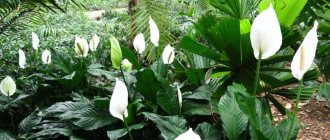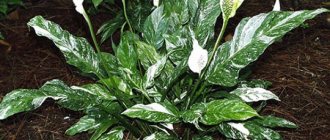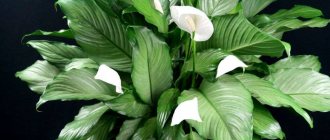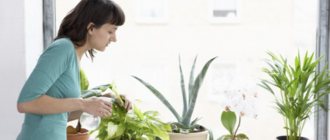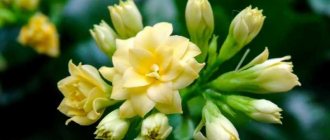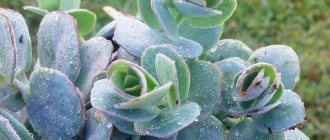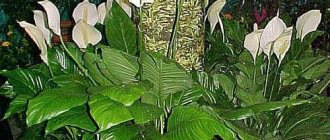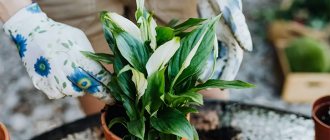Spathiphyllum or women's happiness is a popular indoor flower. Its flowers are similar to calla lilies and are white, pink or cream in color. In order for the plant to actively develop and enjoy regular flowering, you need to know how to replant it correctly.
Transplanting spathiphyllum at home is required 2-4 weeks after purchase, since in flower shops the plants sit in poor but loose “transport” soil. This soil is not suitable for permanent cultivation.
If a flowering specimen is purchased, then the bush is replanted after flowering.
A transplant will be required for female happiness when the bush grows and a baby is formed in the pot - young shoots. When transplanting, the young are separated from the mother plant.
This Old Spathiphyllum Plant Needs Dividing
Description of the spathiphyllum plant
The bush has no stems; small leaves grow directly from the roots, forming thick green tufts. The roots are quite short. Small tubercles are visible on the stem bud. These are aerial roots, characteristic of plants of the Araceae family. The leaf blade is oval-elongated, pointed, with a noticeable midrib.
What does the plant look like?
The lateral veins are also clearly visible. Small flowers form a white spadix on a long peduncle, around which on one side there is a white oval blanket with a pointed tip. The name spathiphyllum reflects the specific appearance of the flower: in Greek, “spatha” means bedspread, and “phyllum” means leaf.
The graceful flowering of spathiphyllum lasts several weeks, from mid-spring to July. Some varieties bloom from late March to early autumn. With good care, the plant also produces flowers in the fall.
If spathiphyllum does not bloom for a long time, replanting, carried out in accordance with the correct recommendations, will activate the vitality of the plant. For popular indoor culture, the dormant period begins in October and lasts until January. At this time, ensure a temperature of at least 16 ° C and infrequent watering. With high air humidity, flower stalks are created in winter.
For the successful development of spathiphyllum, the following requirements must be met:
- constant high air humidity;
- moderate watering so that the substrate is constantly slightly moist;
- abundant spraying, since the plant comes from tropical forests;
- location in an area of diffused light or artificial lighting, but not in direct sunlight;
- Northern exposure or placement on attached platforms near windows is preferable;
- comfortable temperature within 20-23 °C.
Important! If spathiphyllum is constantly in deep shade, the leaves become small.
What available containers can you take to grow a flower?
In household supplies you can find ceramic pots for baking in the oven. By making holes in the bottom for drainage, you can get a good vessel for planting spathiphyllum.
Bowls, both large and small, are also suitable - they are not high, but wide enough. You can consider salad bowls of different sizes as pots for these plants . A prerequisite is the presence of drainage holes.
Spathiphyllums grow well with proper care. The above tips will help you understand the features of planting and growing plants.
Why there is a need to transplant spathiphyllum
The plant develops well if there is sufficient space for the roots. Spathiphyllum transplantation at home is carried out in the following cases:
- the bush has just been purchased and is in a small pot;
- regularly every 3-5 years in the spring to ensure development, since the bush grows quickly and the roots intertwine, wrap around the entire substrate, and protrude to the surface;
- if the lower leaves dry out inside the bush;
- for propagation, choosing from a bunch a fragment where there is a growing point and roots.
Spathiphyllum - home care, why the tips of the leaves dry out
There is another important reason when you need to think about how to transplant spathiphyllum faster: in the absence of flowering.
Additional Information. Replanting will not be necessary if the tops of the leaves turn yellow. This is a sign that the air in the room is too dry for spathiphyllum.
Answers to frequently asked questions
Beginning flower growers who have planted spathiphyllum have questions about care. Finding answers in a timely manner will help you avoid annoying mistakes that can harm the plant.
Is it possible to replant a flowering plant?
The question of whether it is possible to replant spathiphyllum when it blooms arises quite often. This is not recommended, since after the transplant there is an adaptation period. The plant spends resources on developing new space and flowering will stop prematurely.
The appearance of white blankets indicates that the plant is comfortable and there is no urgent need for urgent replanting.
How to replant a blooming spathiphyllum
If the need nevertheless arises (disease, pest infestation, broken pot), then the plant can and should be replanted.
This must be done using the transshipment method, as carefully as possible. Treat the new pot and soil with steam or another method. Be prepared for the fact that flowering will stop, but the bush will be saved.
Why did the newly transplanted spathiphyllum drop its leaves?
There may be several reasons for such an unpleasant metamorphosis:
- improper watering regime (lack of moisture, excess moisture and root rotting);
- indoor air is too dry;
- low air temperature or one-time hypothermia;
- heavy soil.
You need to observe the plant, change watering, and eliminate the possibility of disease or exposure to pests. It is possible that such a reaction is simply a shock that Women’s Happiness can cope with on its own.
Why do the lower leaves of transplanted spathiphyllum turn yellow?
The leaves turn yellow due to insufficiently humidified air. The plant should not just be watered, but sprayed with a spray bottle.
Post-Purchase Replanting Guide
Orchid care at home: options for propagating and planting a flower
A plant from a store is replanted after 15-25 days. The waiting time before replanting the spathiphyllum serves to adapt it to new conditions in a residential building. Temperature and light conditions change sharply for the bush. Immediate planting in a new substrate will be an unnecessary stress factor. Overgrown bushes are usually moved by transshipment, without breaking the old earthen ball.
Roots
Step-by-step actions when you need to plant a recently purchased and already acclimatized plant:
- before transplanting, the spathiphyllum in the container is watered abundantly;
- when the water is absorbed, carefully remove the plant, inspect the roots and select the used drainage;
- place the plant in a new pot on a laid drainage and a small layer of soil, if necessary, straighten the protruding shoots and sprinkle them with soil;
- the top layer of the substrate is compacted and watered;
- If the substrate settles after watering, add prepared soil.
Features of transplanting flowering spathiphyllum
It happens that a problem suddenly arises, how to plant spathiphyllum in bloom. The plant will tolerate summer movement without traumatic consequences. The following rules are adhered to:
- the substrate is watered abundantly, then after 30-40 minutes it is removed from the container;
- if the transplant is carried out due to signs of disease, inspect the roots and cut off the rotten ones with a sharp, disinfected knife, and also shorten those that are too long;
- cut off the flower stalks at the base with pruning shears so that the plant directs energy only to adaptation to the new substrate;
- remove yellowed, wilted leaves and those that have just begun to form;
- The renewed bush is placed in a pot, the substrate is added and compacted.
You can plant a large, developed spathiphyllum bush as a whole; it is better to divide it into several parts with healthy rhizomes. If transshipment is carried out without much intervention in the root system, several young flowers are left and the old ones are removed.
Peduncles
When creating comfortable conditions for spathiphyllum after transplantation, care is taken to ensure sufficient humidity. During the first 10-13 days, a frame is installed above the bush, and a plastic film is placed on top. The shelter will protect the plant from rapid evaporation of moisture.
During this period, water the substrate after the top layer becomes dry. The leaves are sprayed once a day. In the case when the leaf blades droop, spraying is increased more often, up to 2-3 times a day.
Note! When moving a plant from one container to another, the primordia of aerial roots are left on the surface. The shoots gradually increase in size and go deeper into the soil.
Features of the flower “female happiness”
Usually spathiphyllums are hardy and unpretentious. But there are varieties that are capricious and sensitive to any errors in content. For example, a flower cannot tolerate stagnation of water and dies because of this.
It should be borne in mind that the root system of the plant develops to the sides, and not downwards, so the pots of an adult flower should be wide and shallow.
The root system does not tolerate overheating or hypothermia , so it is advisable to use vessels that do not allow these phenomena.
Selection rules
Spathiphyllum chopin - description of a home flower
When planting a large spathiphyllum bush or transferring a purchased plant into a new container, pay attention to the choice of pot and soil recommended for indoor culture.
Potty
When choosing which pot is needed for spathiphyllum, determine the size of the previous one. The plant is planted in a container that exceeds the former container by 1.5-2 cm in width and height. Flower growers have noticed that spathiphyllum blooms profusely when the roots cover the entire substrate.
Trimming
In a pot that is too spacious, the bush will grow its root system and only then throw out its flower stalks. Containers with holes in the bottom through which excess water flows into the pan after watering are suitable. As with any indoor plant, spathiphyllum requires 1-2 cm of drainage.
Ground
Spathiphyllum develops well in a slightly acidic substrate, pH 5-6.5, loose and light in structure. In such soil mixtures, excess moisture seeps into the pan. The retail chain chooses a universal mixture for aroid or tropical flowering plants, which is mixed with a handful of sand. Many gardeners prepare their own substrate. You can choose the appropriate one, usually the simplest one in execution, from several options:
- 3 parts peat, 2 parts leaf soil, 1 part each humus, sand and bone meal;
- 1 part leaf soil, peat, humus, sand, 2 parts turf soil;
- 1 part of leaf soil and peat, half of turf soil and sand.
Pot
Peat is used as riding peat. Tree bark, coconut fiber, charcoal and brick chips are also added to the substrate for looseness. Additives make up no more than 10% of the total mass. They also put sphagnum moss, which protects the soil mixture from drying out.
When replanting, add fertilizer - 0.5 teaspoon of superphosphate. If the substrate is prepared independently, the soil is spilled with a dark pink hot solution of potassium permanganate.
Fertilizers
For good flowering, spathiphyllum is regularly supported with fertilizing, otherwise a beautiful green bush will grow, but without the original white spathes with flower cobs. Or the flower stalks will be thrown out for a short time and at long intervals. It is especially important to feed the plant in the spring and summer, when all processes are activated: once every 10-16 days.
Priming
In winter, when indoor crops enter a dormant period, fertilize the substrate once every 30 days. Spathiphyllum responds well to organic fertilizers that can be purchased in stores, especially bird droppings. Any universal preparations for flowering indoor plants are also suitable: “Flower”, “Azalea” and others.
If fertilizers are not applied at the end of February or March, the spathiphyllum stops blooming in June, and flower stalks do not form again. At the same time, you should not give too much nitrogen preparations, since the green mass will grow, but not the buds.
Note! Flower growers have noticed that the appearance of brown spots on the leaf blades is evidence of excess nutrients.
Housewives often water “female happiness” with chilled liquid after boiling pasta or potatoes, using water from the aquarium. In late autumn and winter, when the intensity of natural light decreases, humic fertilizer “Universal plant balm” is used for spathiphyllum. The drug stimulates the culture and helps to survive the lack of light.
Possible mistakes
If the spathiphyllum, despite care, feels bad, the leaves droop and turn black, growth slows down, and there are no flowers, then it doesn’t like something. Which error has a detrimental effect on the condition of the flower?
- the leaves dry out, the turgor decreases, they turn yellow and wither - insufficient watering. It is important to spray the plant with warm water; you can give it a hot shower;
- the plant withers, does not grow after transplantation, the tips of the leaves begin to turn black - excessive watering, stagnation of water in the soil, incorrectly selected soil or pot;
- new leaves do not grow, does not bloom, although it looks healthy - the pot is too spacious, which is difficult for the plant to inhabit.
How to choose the right time for a transplant
The best time for a planned spathiphyllum transplant is spring. Changing the soil mixture will give the plant new nutrients, the roots will quickly gain mass, and buds will begin to form. During this period, overgrown bushes are also planted.
The green island of spathiphyllum with graceful leaves and white bracts needs to be replanted from time to time. Replacing the substrate and fertilizing have a beneficial effect on the development of indoor plants and stimulate a new wave of flowering.
What to plant in for co-growing with anthurium?
Both plants have similar-shaped flowers, but the volume of the pot and the amount of soil for growth and flowering are different. Spathiphyllum blooms only after the roots are crowded, and anthurium roots need a lot of free space and a large pot.
There are two options for growing them together:
- Plant plants in different pots, but combine them in a common pot or beautiful basket.
- For planting, choose a special elongated pot with an internal partition, into two unequal parts. Plant spathiphyllum in the small part, and anthurium in the large part.
